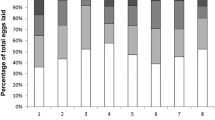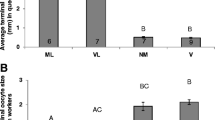Abstract
The mechanisms of regulating worker reproduction in bumblebees were studied by direct behavioral observations and by measuring ovarian development and juvenile hormone (JH) biosynthesis rates in workers under different social conditions. Workers in the last stage of Bombus terrestris colony development (the competition phase) had the lowest ovarian development and JH biosynthesis rates. Callows introduced into colonies immediately after queen removal (dequeened colonies) demonstrated a significant increase in ovarian development before, but not during, the competition phase. These findings differ from the higher ovarian development in colonies during the competition phase predicted by the prevailing hypothesis that worker reproduction starts in response to a decrease in queen inhibition. Reproduction of callows housed with dominant workers in small queenless groups was inhibited as in queenright colonies. This suggests that the reduced ovarian development and JH biosynthesis rates observed in dequeened and normally developing colonies during the competition phase also reflect inhibition by dominant workers. Thus, two distinct stages of inhibition of reproduction seem to exist: (1) before the competition phase, when the queen slows down worker ovarian development and prevents oviposition; (2) during the competition phase, when dominant workers inhibit ovarian development of other workers. Between these stages there seems to be a temporal “window” of enhanced worker reproductive development. The queen's typical switch to haploid egg production was not associated with changes in worker ovarian development or JH biosynthesis rates. These findings suggest that regulation of worker reproduction in B. terrestris is not determined by simple changes in the queen's inhibition capacity or by the sex of offspring and that the worker's role is more important than previously believed.
Similar content being viewed by others
Author information
Authors and Affiliations
Additional information
Received: 18 March 1998 / Accepted after revision: 18 July 1998
Rights and permissions
About this article
Cite this article
Bloch, G., Hefetz, A. Regulation of reproduction by dominant workers in bumblebee (Bombus terrestris) queenright colonies. Behav Ecol Sociobiol 45, 125–135 (1999). https://doi.org/10.1007/s002650050546
Issue Date:
DOI: https://doi.org/10.1007/s002650050546




